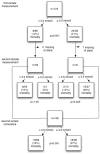The prognostic value of blood lactate levels relative to that of vital signs in the pre-hospital setting: a pilot study
- PMID: 19091118
- PMCID: PMC2646325
- DOI: 10.1186/cc7159
The prognostic value of blood lactate levels relative to that of vital signs in the pre-hospital setting: a pilot study
Abstract
Introduction: A limitation of pre-hospital monitoring is that vital signs often do not change until a patient is in a critical stage. Blood lactate levels are suggested as a more sensitive parameter to evaluate a patient's condition. The aim of this pilot study was to find presumptive evidence for a relation between pre-hospital lactate levels and in-hospital mortality, corrected for vital sign abnormalities.
Methods: In this prospective observational study (n = 124), patients who required urgent ambulance dispatching and had a systolic blood pressure below 100 mmHg, a respiratory rate less than 10 or more than 29 breaths/minute, or a Glasgow Coma Scale (GCS) below 14 were enrolled. Nurses from Emergency Medical Services measured capillary or venous lactate levels using a hand-held device on arrival at the scene (T1) and just before or on arrival at the emergency department (T2). The primary outcome measured was in-hospital mortality.
Results: The average (standard deviation) time from T1 to T2 was 27 (10) minutes. Non-survivors (n = 32, 26%) had significantly higher lactate levels than survivors at T1 (5.3 vs 3.7 mmol/L) and at T2 (5.4 vs 3.2 mmol/L). Mortality was significantly higher in patients with lactate levels of 3.5 mmol/L or higher compared with those with lactate levels below 3.5 mmol/L (T1: 41 vs 12% and T2: 47 vs 15%). Also in the absence of hypotension, mortality was higher in those with higher lactate levels. In a multivariable Cox proportional hazard analysis including systolic blood pressure, heart rate, GCS (all at T1) and delta lactate level (from T1 to T2), only delta lactate level (hazard ratio (HR) = 0.20, 95% confidence interval (CI) = 0.05 to 0.76, p = 0.018) and GCS (HR = 0.93, 95% CI = 0.88 to 0.99, p = 0.022) were significant independent predictors of in-hospital mortality.
Conclusions: In a cohort of patients that required urgent ambulance dispatching, pre-hospital blood lactate levels were associated with in-hospital mortality and provided prognostic information superior to that provided by the patient's vital signs. There is potential for early detection of occult shock and pre-hospital resuscitation guided by lactate measurement. However, external validation is required before widespread implementation of lactate measurement in the out-of-hospital setting.
Figures



Comment in
-
Extending the role of lactate measurement into the prehospital environment.Crit Care. 2009;13(1):115. doi: 10.1186/cc7687. Epub 2009 Feb 10. Crit Care. 2009. PMID: 19232076 Free PMC article. Review.
Similar articles
-
The predictive value of variables measurable in the ambulance and the development of the Predict Sepsis screening tools: a prospective cohort study.Scand J Trauma Resusc Emerg Med. 2020 Jun 25;28(1):59. doi: 10.1186/s13049-020-00745-6. Scand J Trauma Resusc Emerg Med. 2020. PMID: 32586337 Free PMC article.
-
Derivation and Validation of Predictive Factors for Clinical Deterioration after Admission in Emergency Department Patients Presenting with Abnormal Vital Signs Without Shock.West J Emerg Med. 2015 Dec;16(7):1059-66. doi: 10.5811/westjem.2015.9.27348. Epub 2015 Dec 8. West J Emerg Med. 2015. PMID: 26759655 Free PMC article.
-
Prehospital serum lactate as a predictor of outcomes in trauma patients: a retrospective observational study.J Trauma. 2011 Apr;70(4):782-6. doi: 10.1097/TA.0b013e318210f5c9. J Trauma. 2011. PMID: 21610386
-
Extending the role of lactate measurement into the prehospital environment.Crit Care. 2009;13(1):115. doi: 10.1186/cc7687. Epub 2009 Feb 10. Crit Care. 2009. PMID: 19232076 Free PMC article. Review.
-
Role of serum lactate as prognostic marker of mortality among emergency department patients with multiple conditions: A systematic review.SAGE Open Med. 2023 Jan 10;11:20503121221136401. doi: 10.1177/20503121221136401. eCollection 2023. SAGE Open Med. 2023. PMID: 36643203 Free PMC article. Review.
Cited by
-
Renaissance of base deficit for the initial assessment of trauma patients: a base deficit-based classification for hypovolemic shock developed on data from 16,305 patients derived from the TraumaRegister DGU®.Crit Care. 2013 Mar 6;17(2):R42. doi: 10.1186/cc12555. Crit Care. 2013. PMID: 23497602 Free PMC article.
-
Relative hyperlactatemia and hospital mortality in critically ill patients: a retrospective multi-centre study.Crit Care. 2010;14(1):R25. doi: 10.1186/cc8888. Epub 2010 Feb 24. Crit Care. 2010. PMID: 20181242 Free PMC article.
-
Damage Control Resuscitation.Chirurgia (Bucur). 2017 Sept-Oct;112(5):514-523. doi: 10.21614/chirurgia.112.5.514. Chirurgia (Bucur). 2017. PMID: 29088551 Free PMC article. Review.
-
Lactate level as a predictor of outcomes in patients with acute upper gastrointestinal bleeding: A systematic review and meta‑analysis.Exp Ther Med. 2024 Jan 24;27(3):113. doi: 10.3892/etm.2024.12401. eCollection 2024 Mar. Exp Ther Med. 2024. PMID: 38361514 Free PMC article.
-
Utility of the early lactate area score as a prognostic marker for septic shock patients in the emergency department.Acute Crit Care. 2019 May;34(2):126-132. doi: 10.4266/acc.2018.00283. Epub 2019 Apr 12. Acute Crit Care. 2019. PMID: 31723917 Free PMC article.
References
-
- Dunham CM, Siegel JH, Weireter L, Fabian M, Goodarzi S, Guadalupi P, Gettings L, Linberg SE, Vary TC. Oxygen debt and metabolic acidemia as quantitative predictors of mortality and the severity of the ischemic insult in hemorrhagic shock. Crit Care Med. 1991;19:231–243. doi: 10.1097/00003246-199102000-00020. - DOI - PubMed
MeSH terms
Substances
LinkOut - more resources
Full Text Sources
Other Literature Sources
Medical

